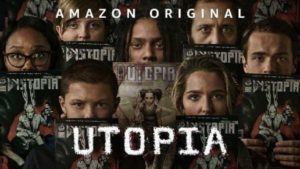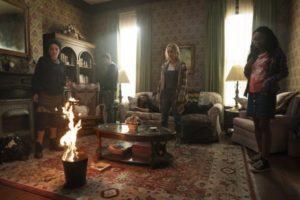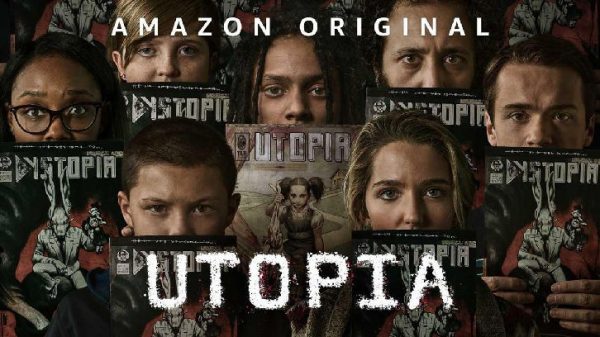In a career which spans over two decades, Fuse FX’s VFX Supervisor Wayne England has worked on projects as diverse as Castle Rock, Watchmen and the forthcoming Loki. Recently he took time out to talk to Martin Carr about his involvement with Amazon’s Utopia.

Having worked on both Watchmen and now Utopia, what is it about this particular subject matter that keeps you coming back?
Aside from the good fortune of aligning with such great projects, I’m certainly attracted to shows and creative content that address themes that have a vibrant relevance to our contemporary social and cultural issues. The through line within these two very different shows is the graphic novel’s power to so directly and immediately capture the imagination with layered, storied visual symbolism. I tend to experience an additional wind in my sails from the inspiration of working in the service of creative content that provokes deeper societal questions that allude to awakening shifts in perspective. The opportunity to collaborate directly with creatives such as Gillian Flynn is itself also inspiring.
In your opinion, how did VFX influence the overall look of Utopia?
My primary aim for our VFX was to realize a next-level quality. At the outset, this was about delving deeply into the story and gaining a sensibility toward all the unique creative choices made to cumulatively render the tone of the show. With that, a level of discernment can arise that aligns VFX choices in good directions. For exceptional supporting VFX, seamless integration is half the target, while the other is a perception into how the VFX can express nuanced qualities that enhance the story’s highest aspirations. Of course, this is all dependent upon talents of the team and the organizational infrastructure that enables our focus to rest upon the art itself. I felt our team and FuseFX executed beautifully for Utopia – in particular, our compositing supervisor Heather McAuliff, our CG supervisor Christian Gonzales and FX supervisor Wayne Hollingsworth. It was also wonderful to hear from Gillian Flynn and Amazon that they were “blown away” by so much of our work.

Aside from the torture scenes, Utopia appears character rather than effects driven. How did VFX underpin those dramatic elements?
There are two primary categories for how our supporting VFX integrated dramatic elements for the Utopia characters. Firstly, it was our augmenting, enhancing and bringing to life the settings and environments within which the characters were immersed. These digital set extensions ranged from driving comps, to complex CG interior factories, to sprawling makeshift tent village hospitals (with 100 plus animated digi-doubles), to a massive CG interior warehouse.
The second category is the VFX we applied to characters themselves, which were mainly gore themed. Wilson’s eye socket factored largely across over 70 shots. There were also bullet impacts with fluid FX blood spray, knife and object impaling wounds and stunt team face replacements. I felt I had some good perspectives for the gore shots with my background as a fluids FX specialist. Along with some experience supervising a couple of other recent shows with gore themes, I knew what was important was to strike a balance between hyperrealism and theatrical effect. Not surprisingly, realism often took the more supporting role with the blood FX amounts, sizes and distances travelled, which enhanced the desired dramatic impact.
What creative input did director Toby Haynes and writer Gillian Flynn have in the VFX process?
Coming onto the show close to the end of shooting, my focus was primarily the post visual effects, so I didn’t cross paths with Toby, but did meet a number of times with showrunner Gillian Flynn and producer Jessica Rhodes. Along with FuseFX’s brilliant VFX producer Gary Romey, we met with them for the VFX blocking sessions and creatively defined the vision for VFX shots across various episodes. We shared these meetings with Utopia’s impressive post-producing duo of Nick Fuentes and Huey Park. As the writer and showrunner, Gillian’s creative input was already present in every shot, but we exchanged ideas fluidly with her to help elevate the effectiveness of our visual effects with the story. As an admirer of her work, it was an honor to be entrusted to realize her vision for so many of the epic and climactic moments in addition to our seamlessly “hidden” VFX.

Few television shows could be more topical at the moment. What were the biggest challenges you faced bringing this world to life?
A pandemic interrupting a show featuring a pandemic is multiple levels of irony. But all things considered, for us it was more a case of what could have been the biggest challenge. Which is to say while deep in production, working on multiple episodes of Utopia, we were required to transition to a remote pipeline in what seemed like just a few days. There have been some minor optimizations along the way, but thanks to the brilliance of FuseFX IT, we’re still using the same highly effective remote system today.
In terms of actual shot work, Episode 8’s climactic collapse of the warehouse qualifies as the most challenging sequence. This was due to the warehouse’s huge scale, the close-up CG interactive shots with Rainn Wilson, the extreme degrees of precision required for animation, simulation timings and realism, in addition to close-up and wide shading and lighting requirements to integrate perfectly with all remaining live action components of the shots.
With Utopia to what extent do you think art is imitating life?
Pandemic double vision aside, Utopia is a disruptive work of art. How people interpret its symbolism is relative to what one’s looking to find. There are undeniably many layers of meaning.
A fun fact for the warehouse collapse scenes: we did reference a YouTube video of a forklift driver in a warehouse who accidentally triggered multiple rows of 15-foot-tall storage shelves to collapse like dominos. The only difference was Rainn Wilson’s character was trying for the domino effect.

If you had the opportunity to create your own graphic novel from the ground up, who would be the chief influences and why?
Given themes of contemporary actualization of inspired visionary disruption and positively affecting our planet and civilization, I would reference Elon Musk for raw inspiration. Also, Frank Herbert for world creation and archetypal themes of ascendant liberation from fear. I would commission my pal Alex Nice for the illustrations.
What are the key considerations for you when it comes to signing on to any project?
My ideal is finding opportunities to work with people and teams in contexts where raw inspiration is vibrant among us, and when the content of the work is bold, powerful and positively disruptive. Overall, good people and good vibes.
Describe your perfect Sunday afternoon.
Playing some soccer in the back yard with our 12-year-old, improvising on the piano, playing with Niagara in UE4, and reading a great book out loud with the lovely Mrs. England.
Utopia is streaming on Amazon Prime Video now.
Many thanks to Wayne England for taking the time for this interview.



